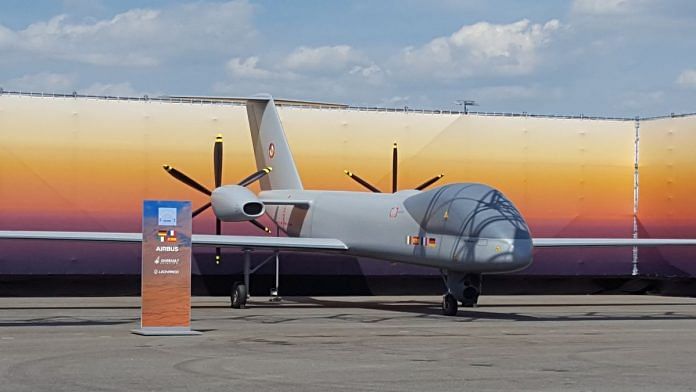New Delhi: India has, as an observer state, officially joined the Medium Altitude Long Endurance Remotely Piloted Aircraft System (MALE RPAS) or Eurodrone programme, managed by the Bonn-based Organisation for Joint Armament Cooperation (OCCAR) and led by Taufkirchen-based aerospace company Airbus Defence and Space.
A formal request to join the programme was made in August 2024, with acceptance coming just days before Aero India 2025 in Bangalore, Asia’s largest military aviation exhibition.
Eurodrone is a four-nation initiative involving Germany, France, Italy, and Spain. The programme, led by Airbus Defence and Space (Germany), includes Leonardo (Italy), Dassault Aviation (France), and Airbus (Spain) as major subcontractors.
“This move demonstrates India’s willingness to explore collaborative opportunities on shared interests with Europe,” OCCAR said in a statement.
OCCAR-executive administration director Joachim Sucker has handed over the letter of approval (LoA) to Ajit Gupte, India’s ambassador to Germany.
India follows Japan, which became the first official OCCAR observer state in the MALE RPAS (Eurodrone) programme in November 2023.
Also Read: Complex network of India’s existing air defence capabilities & the way forward
All about Eurodrone
The Eurodrone is a remotely piloted aircraft system (RPAS) designed for long-endurance missions such as intelligence, surveillance, target acquisition, and reconnaissance (ISTAR), maritime surveillance, anti-submarine warfare, and airborne early warning.
Conceived as a “European Programme for European Sovereignty,” the initiative was founded in 2022 and passed its preliminary design review (PDR) in 2024. The drones are expected to enter service by 2030. Eurodrone is the first RPAS designed for “safe and reliable flight in non-segregated airspace,” according to Airbus.
With a maximum mission payload of 2.3 tonnes and an endurance period—maximum time an aircraft can stay in the air using a single load of fuel—of up to 40 hours, the drone offers superior capabilities compared to other existing remotely piloted aircraft systems.
Equipped with a twin-engine configuration, the drone is designed for operations in diverse environments, including severe weather conditions. Airbus says it prioritises the platform’s sovereignty over operations and data management, ensuring exclusive and confidential data handling through secure connectivity between the aircraft and the user’s network.
India’s participation in Eurodrone builds on past collaborative efforts. Previously, India joined Russia’s Su-57 fighter programme but withdrew in 2018. In October last year, India signed a contract with the US for 31 Predator drones and continues to pursue indigenous Unmanned Aerial Vehicle (UAV) projects like Tapas and Rustom, though progress has been slow.
Becoming a full-time Eurodrone observer will require India to bear costs for technical expertise. This partnership is expected to enhance defence cooperation with Europe, complementing projects such as the C-295 aircraft manufactured by Tata and Airbus in India, the Rafale M purchase for naval operations, and the expected contract for additional Scorpené-class submarines.
The Eurodrone programme is part of Europe’s collective defence strategy, reducing reliance on US and Israeli platforms such as the Reaper and Heron drones, respectively. Valued at €7.1 billion, the programme aims to develop, produce, and support 20 systems, each comprising three UAVs and two ground stations.
Other European collaborative defence projects include the Eurofighter jet, the European Patrol Corvette (EPC) for navies, and the Future Combat Air System (FCAS), which seeks to create next-generation fighter jets.
The first Eurodrone flight is scheduled for 2026, with initial deliveries expected by 2028. As European nations continue to pool resources for defence innovation, India’s involvement signals a strategic step in strengthening ties and advancing its own defence capabilities.
(Edited by Radifah Kabir)
Also Read: ‘Joint culture needed first’ — CDS Gen Chauhan outlines first steps on the road to theaterisation




